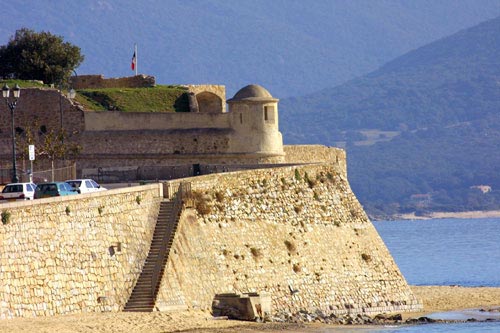Ajaccio Citadel

Ajaccio Citadel. Source : http://domy66000.canalblog.com
The citadel, which was built in 1492, was a base of operations complementary to Calvi and Bonifacio.
Ajaccio, which is set at the top of a gulf, has been inhabited since Ancient times. From the 12th century onwards, the Genoese, wishing to establish a base of operations to support Calvi and Bonifacio in defending them against the threat from the Barbary Coast, built a fortification on the site, named Castel Lombardo.
Unfit for habitation, the position was abandoned three centuries later in 1492-1493 in favour of Capo di Bollo at Leccia Point. Cristoforo de Gandino, Francesco Sforza's military architect, was appointed by the Company of St. George to carry out the work for this site and at Calvi. Genoese and Ligurian families including the Bonapartes then set up a populating colony.
At that time, the town was structured around a fan formation of three roads: the Strada del Domo, the Strada San Carlo and the Strada Dritta, to plans drawn by the architect Pietro da Mortara. The citadel, which was built at the same time, was initially made up of a keep or citadel (castello) and a low curtain wall. In 1502-1503, the defensive features were enhanced with a ditch dug in rock around the citadel, accessible via a drawbridge, and strong walls around the settlement.
The town, which fell under French control between 1553 and 1559 was modified and extended, taking on its current hexagonal shape, the corners of which were reinforced with bastions. The Cateau-Cambrésis treaty returned the town to the Republic of Genoa, which commissioned the engineer Jacopo Frattini to fortify the seafront. He had a bastion built there, separated from the town by a ditch. During the 18th century, Corsica struggled in vain to escape foreign domination; in 1729, 1739 and 1763 the islanders attempted to take control of Ajaccio but it was placed directly under French control when the Genoese sold the island to France in 1768.
Napoleon Bonaparte was born in this town, and biographers tell that the ramparts and the citadel fuelled his games and dreams before featuring in his military and political career.
Used as a prison during the Second World War, Ajaccio Citadel was to be the last destination of the heroic Resistance fighter Fred Scamaroni. Scamaroni, who created the Gaullist Corsican Action R2 network in 1941, was mandated by General de Gaulle in January 1943 to try to bring unity to the Resistance movement. Betrayed by his radio operator, he was arrested by the OVRA (Italian counter-espionage) during the night of 18-19 March 1943. He chose to cut his throat with a piece of wire, leaving a last message written in his own blood: "Long live France and long live de Gaulle".
The citadel belonged to the Ministry of Defence until it was passed over to the city of Ajaccio in 2005.
Ajaccio city tourist office
3, Bd du Roi Jérôme BP 21 20000 Ajaccio
Tel: +33 (0)4 95 51 53 03
Fax: +33 (0)4 95 51 53 01

La citadelle d'Ajaccio. Sources : Ville d'Ajaccio
Practical information
Boulevard Danielle Casanova 20000
Ajaccio
Tél. : +33 (0)4 95 51 53 03Fax : +33 (0)4 95 51 53 01
Accessibilité toute l'année




